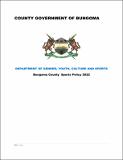Policy Brief No. 10 of 2023-2024 on Pioneering Livestock Management through Radio Frequency Identification Technology in Kenya’s Arid and Semi-Arid Lands: Insights from Botswana
Publication Date
2023Author
Type
KIPPRA Publicationsviews
downloads
Metadata
Show full item recordBy
Matofari, Adrian & Omariba, Vivian
Abstract/
Arid and Semi-Arid Lands (ASALs) in Kenya stand at the focal point of agricultural challenges and economic opportunities. Livestock, a mainstay of these regions, plays a key role in driving economic growth and ensuring food security for the communities inhabiting these arid landscapes. The livelihoods of a significant portion of the population are intricately woven into the fabric of livestock rearing, making it not just an economic activity but a way of life. The immense contribution of the livestock sector to the economy cannot be overstated, with a substantial share of the GDP attributed to the livestock industry. As these regions grapple with the unique challenges posed by aridity and semi-aridity, harnessing innovative technologies such as Radio-Frequency Identification (RFID) becomes imperative to elevate the efficiency, sustainability, and traceability of livestock management. Botswana’s successful implementation of the Livestock Identification and Traceability System (LITS) serves as a compelling model for Kenya for several reasons. Firstly, Botswana shares a similar ecological context, characterized by arid conditions and scarce resources. The LITS in Botswana effectively navigated these challenges, showcasing the adaptability of the system to harsh environmental realities. Secondly, the positive impact of LITS on Botswana’s livestock sector is evident in improved disease control, market access, and overall economic gains. By drawing lessons from Botswana, Kenya can glean insights into the practical implementation, challenges faced, and solutions derived from a comparable context, thus streamlining the adaptation of RFID technology to its unique ASALs
Subject/
Radio-Frequency Identification; Livestock Management; Technology; Animal Identification; Arid and Semi-Arid Lands
Publisher
The Kenya Institute for Public Policy Research and Analysis (KIPPRA)Series
PB/10/2023-2024Collections
- Policy Briefs [161]
Related items
Showing items related by title, author, creator and subject.
-
Discussion Paper No. 312 of 2023 on Application of Radio-Frequency Identification Technology in Livestock Management in Botswana: Lessons for Arid and Semi-Arid Lands in Kenya
Matofari, W. Adrian & Omariba, M, Vivian (The Kenya Institute for Public Policy Research and Analysis (KIPPRA), 2023)In Kenya's Arid and Semi-Arid Lands (ASALs), livestock management is a pivotal aspect of sustenance and livelihood for the locals. Recognizing the significance of efficient livestock management, this study delved into ... -
Bungoma County Sports Policy 2022
County Government of Bungoma (County Government of Bungoma, 2022)Devolution is currently regarded as the major Constitutional framework for both growing and developed democracies in the world. The world has embraced this form of governance reforms to achieve global social, economic and ... -
Nyeri County Risk Management Policy 2020
County Government of Nyeri (County Government of Nyeri, 2020)Recent trends in public sector management have laid emphasis on transparency and accountability. This has resulted in increased focus in governance of public institutions and the incorporation of risk management and financial ...




